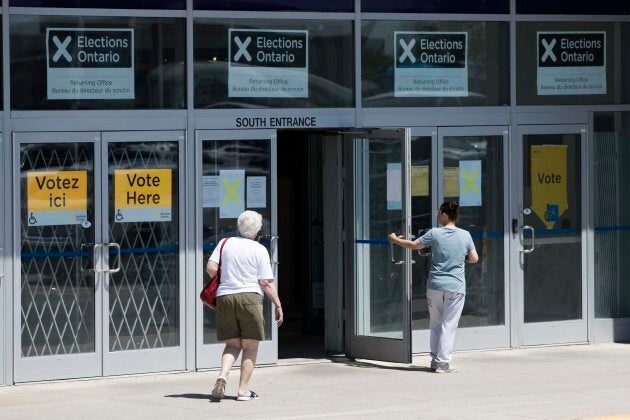What do Ontario voters want? How will they vote on June 7? Many analyses over the past few weeks have identified likely patterns of support for each party and possible election outcomes. But choosing among contestants is not the only way to have our say at the ballot box. Voters can give their ballots back unmarked.

Declining the ballot, as this practice is called, is a way of formally refusing to choose among the options, and has been advocated by an NGO called Democracy Watch as a better option than spoiling and abstention.
Ballot declining is not a widespread practice. In Ontario's last provincial election, about 31,000 voters declined, representing 0.6 per cent of the electorate. This was the highest rate seen in decades, but still a small fraction of the voting public. Indeed, the practice is rare enough that sometimes even returning officers are not familiar with procedures, as one advance voter in Barrie-Innisfil discovered last weekend.
The difference between declining and spoiling a ballot
Declining a ballot is different than spoiling a ballot, although the intentions may be the same.
"Spoiling" refers to ballots that are invalidated because they are marked incorrectly, defaced or destroyed. Spoiled ballots sometimes have emotionally charged, typically negative political messages on them that clearly communicate dissatisfaction. In the count, spoiled ballots are all lumped together, so we do not know how many are truly expressions of opposition.
This raises a larger question about whether declining a ballot is a good idea more generally.
Even if election officials attempted to sort protest from accidental spoiled ballots, this line is not always clear. For example, a voter may mark X next to every candidate's name on the ballot. What conclusion should ballot counters draw? Does the voter like all the candidates, but fail to understand the voting procedures? Or has she rejected all the candidates on the ballot to indicate displeasure with an unappealing choice set? The latter interpretation may make sense given that we use X as a symbol for "no," "nay" or "wrong" in many contexts.
How to decline a ballot
Declining a ballot is not permitted in all jurisdictions. Ontario is only one of three provinces where it is lawful. On Elections Ontario's website, voters who wish to decline are instructed to "tell the election official that you are declining your right to vote when they hand you a ballot. This is a public process and is done out loud. The election official will mark 'declined' on the election documentation."
Democracy Watch is correct, then, that declining is a clearer expression of alienation or opposition than spoiling. However, is the message really all that clear? This raises a larger question about whether declining a ballot is a good idea more generally.
Declining a ballot is not the best way to make a statement
In terms of the meaning behind the act, Democracy Watch and others equate declining the ballot to voting for "none of the above," indicating disapproval of all the candidates offered for election. But that is not the formal meaning of a ballot decline. Elections Ontario does not attribute a specific meaning to declining a ballot, in part because there are a variety of motivations.
It can be done in protest of the institutions that structure the political process, such as the electoral rules or indeed the very system of government we use.
An anti-system protest is different than a "none of the above" statement.

Declining a ballot could also be motivated by low trust in government; a generalized lack of confidence in politicians and their intent; or ability to deliver on campaign promises.
The meaning behind declined ballots cannot be known, beyond some broad dissatisfaction on the voter's part. If a voter's goal is simply to express political disaffection, this method is fine, but it offers no guidance to officials or the political system about the nature of the voter's beef with the system or how to remedy it.
If the message is very general, and no reform can come from it, what is the point?
One of our key responsibilities is to communicate our views about which parties and candidates are best equipped to take charge of government.
How voters can make their concerns heard
Practically speaking, declining and spoiling seem contrary to voters' obligations, as well as to their interests.
In representative democracy, one of our key responsibilities is to communicate our views about which parties and candidates are best equipped to take charge of government. Declining a ballot withdraws this important input from a system whose design requires it.
Moreover, even when none of the candidates in an election is seen to be optimal — as must be the case for a sizeable portion of the electorate in any given race — voters still have preferences about which candidate is better than the rest. There is still something to be gained by voting, because there is always one candidate in the mix whose views are most proximate to yours.
Why abdicate the opportunity to select your most favoured (or least-despised) candidate?
More from HuffPost Canada:
Voting is about communicating preferences, not about finding the perfect candidate whose views all match your own. The system rarely provides a close match, and is under no obligation to do so.
In the post-Liberal surrender, the question of what to do at the ballot box seems especially important. We have a two-way race between parties on opposite sides of the political spectrum, both of which have been on the opposition benches for some time. This is a change election — a transition to something new after a period of Liberal dominance.
The system needs Ontario voters to guide it, not refuse to choose.
Also on HuffPost: